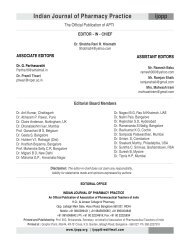Oct-Dec, 2011 - Indian Journal of Pharmacy Practice
Oct-Dec, 2011 - Indian Journal of Pharmacy Practice
Oct-Dec, 2011 - Indian Journal of Pharmacy Practice
- No tags were found...
You also want an ePaper? Increase the reach of your titles
YUMPU automatically turns print PDFs into web optimized ePapers that Google loves.
Anantha Naik N -Health Related Quality <strong>of</strong> Life InstrumentsSl No Full Name Abbreviated Name11Quality Of Life Indexhttp://psychcorp.pearsonassessments.com/HAIWEB/Cultures/en-QOLIus/Productdetail.htm?Pid=PAg511Social Adjustment Scale - Self Report12 http://cognitivecentre.com/social-adjustment-scaleself-report/index.htmlSAS-SRHealth Survey and SF-12v2 Health Survey SF-36 / SF-36v2 SF-3613Health Survey and SF-36v2TM Health SurveySF-12 / SF- 12v2 SF-12www.qualitymetric.com/ SF 36 / SF 36v21415Sickness Impact Pr<strong>of</strong>ilehttp://www.mapi- trust.org/services/questionnairelicensing/cataloguequestionnaires/118-sipWays <strong>of</strong> Coping Questionnairehttp://www.mindgarden.com/products/wayss.htmSIPWAYSThe desirable instrument should be having the pro<strong>of</strong> <strong>of</strong>A) Reliability (consistency in ratings),B) Validity (representation <strong>of</strong> theoretical constructs) andC) Responsiveness (detect even small changes)A) Reliability:Reliability quests the consistency <strong>of</strong> the instrument, does theinstrument produce same score on repeated administrations?Thus confirming the extent to which the instrument is devoid<strong>of</strong> error. Reliability quests the discrimination power <strong>of</strong> theinstrument between individuals in a given populationconsistently when respondents are in stable health. Reliabilitywill appear greater when measured in a heterogeneous groupwith higher variability in scores between patients (includespatients with no pain to those with severe pain) than in ahomogeneous group <strong>of</strong> patients.There are three types <strong>of</strong> reliability measurements, they area. Test-retest reliabilityb. Internal consistency reliabilityc. Inter-rater reliability8Test-retest reliability evaluates the similarity between healthstatus scores over time when no changes in health haveoccurred. That means if the same person completes HRQoLinstrument and then retakes the same survey after someperiod, if the persons health status has not changed, his or herscores from both attempts should be similar or consistent. It isnormally determined using Cohen's Kappa or Pearson's orSpearman's correlation coefficient. Normally, levels in excess<strong>of</strong> 0.6 indicate adequate test-retest reliability.Internal consistency is an estimate <strong>of</strong> homogeneity <strong>of</strong> itemsmeasuring a specific health domain and is normally measuredusing Cronbach's alpha coefficient. The closer the coefficientis to 1, the greater the homogeneity between the items and,therefore, the greater the confidence. For example considerasking two questions from vitality domain <strong>of</strong> SF-36 HRQoLinstrument to the person, did you feel full <strong>of</strong> pep? and did youhave a lot <strong>of</strong> energy? The questions should produce similaranswer from the person. Internal consistency measure haslimitations as it relates only to the correlation between itemson a single administration, and does not assess the extent <strong>of</strong>variability on repeated administration <strong>of</strong> a measure.Inter-rater reliability assesses the agreement betweendifferent scores collected by administering the sameinstrument in a group <strong>of</strong> healthy people.It should be noted that if an instrument is tested and found tobe reliable yet not precise (invalid), meaning the instrumentcan be reliably incorrect. If the instrument in questionconsistently produces incorrect answer, it is reliable but notvalid.9B) Validity :Validity measurements are essential to confirm that the scoresproduced by the instrument truly represent the basicconstructs <strong>of</strong> HRQoL instrument. In other words, validityassessment <strong>of</strong> an instrument evaluates whether instrument inquestion measures what is intended. For an instrument to bevalid it must first be reliable otherwise it cannot confirm to theview that the instrument produces results which actuallymeasures basic constructs on readministration. Theassessment <strong>of</strong> validity <strong>of</strong> an instrument is easy than thevalidity.There are three types <strong>of</strong> validity measurements, they area. Content validityb. Construct validityc. Criterion validityd. Discriminant validityContent validity evaluates whether the HRQoL instrumentcontain all facets <strong>of</strong> relevant variable <strong>of</strong> interest. Content<strong>Indian</strong> <strong>Journal</strong> <strong>of</strong> <strong>Pharmacy</strong> <strong>Practice</strong> Volume 4 Issue 4 <strong>Oct</strong> - <strong>Dec</strong>, <strong>2011</strong> 27
















